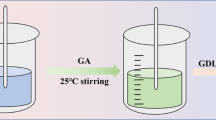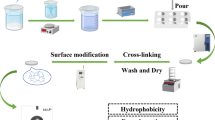Abstract
The research in biopolymer-based superabsorbents is gaining importance in the green chemistry field thanks to their environmentally friendly properties. In this study, a biopolymer-based superabsorbent made of calcium ion crosslinked alginate/carboxymethyl cellulose composite was prepared by a new quasi-cryogelation process, where the complete ionic gelation takes place before the freezing step, in contrast to the conventional cryogelation technique in which gelation occurs under semi-frozen conditions. Thanks to the facile quasi-cryogelation method, the morphology of the gels changed and a significant increase in water absorption properties has been achieved. The swelling properties of the material were investigated in distilled water and different physiological fluids. Results show that the proposed material shows good water absorption property where a water absorption of 2343% was reached and even after five cycles this value was 1200%. As a result, this study reports a biopolymer-based sustainable superabsorbent which is appropriate for various applications such as the removal of pollutants from water or diaper production.









Similar content being viewed by others
Data availability
The raw/processed data required to reproduce these findings cannot be shared at this time due to technical or time limitations.
References
Pham BTT, Duong THT, Nguyen TT et al (2021) Development of polyvinyl (alcohol)/D-glucose/agar/silver nanoparticles nanocomposite film as potential food packaging material. J Polym Res 28:1–14. https://doi.org/10.1007/s10965-021-02761-1
Kaygusuz H, Uzaşçı S, Erim FB (2015) Removal of Fluoride from Aqueous Solution Using Aluminum Alginate Beads. CLEAN - Soil, Air, Water 43:724–730. https://doi.org/10.1002/clen.201300632
Kaygusuz H, Uysal M, Adımcılar V, Erim FB (2015) Natural alginate biopolymer montmorillonite clay composites for vitamin B2 delivery. J Bioact Compat Polym 30:48–56. https://doi.org/10.1177/0883911514557014
Kaygusuz H, Erim FB (2013) Alginate/BSA/montmorillonite composites with enhanced protein entrapment and controlled release efficiency. React Funct Polym 73:1420–1425. https://doi.org/10.1016/j.reactfunctpolym.2013.07.014
Ilgin P, Ozay H, Ozay O (2020) Synthesis and characterization of pH responsive alginate based-hydrogels as oral drug delivery carrier. J Polym Res 27:1–11. https://doi.org/10.1007/s10965-020-02231-0
Lin CC, Chiu JY (2021) Glycerol-modified γ-PGA and gellan composite hydrogel materials with tunable physicochemical and thermal properties for soft tissue engineering application. Polymer 230:124049. https://doi.org/10.1016/J.POLYMER.2021.124049
Kalaycıoğlu Z, Kahya N, Adımcılar V et al (2020) Antibacterial nano cerium oxide/chitosan/cellulose acetate composite films as potential wound dressing. Eur Polym J 133:109777. https://doi.org/10.1016/j.eurpolymj.2020.109777
Donati I, Paoletti S (2009) Material Properties of Alginates. Springer, Berlin, Heidelberg, pp 1–53
Horie K, Barón M, Fox RB et al (2004) Definitions of terms relating to reactions of polymers and to functional polymeric materials: (IUPAC Recommendations 2003). Pure Appl Chem 76:889–906
G R, C.R R, Nair S V., Menon D, (2020) Superabsorbent sodium carboxymethyl cellulose membranes based on a new cross-linker combination for female sanitary napkin applications. Carbohydr Polym 248:116763. https://doi.org/10.1016/J.CARBPOL.2020.116763
Shahi S, Motasadizadeh HR, Zohuriaan-Mehr MJ (2017) Surface modification of superabsorbing hydrogels through a feasible esterification reaction: Toward tunable superabsorbent for hygienic applications. Int J Polym Mater Polym Biomater 66:544–557. https://doi.org/10.1080/00914037.2016.1252348
Mignon A, Graulus GJ, Snoeck D et al (2014) pH-sensitive superabsorbent polymers: a potential candidate material for self-healing concrete. J Mater Sci 50:970–979. https://doi.org/10.1007/s10853-014-8657-6
Snoeck D, Van Tittelboom K, Steuperaert S et al (2014) Self-healing cementitious materials by the combination of microfibres and superabsorbent polymers. J Intell Mater Syst Struct 25:13–24. https://doi.org/10.1177/1045389X12438623
Loh JW, Goh XY, Nguyen PTT et al (2022) Advanced Aerogels from Wool Waste Fibers for Oil Spill Cleaning Applications. J Polym Environ 30:681–694. https://doi.org/10.1007/s10924-021-02234-y
Ersen Dudu T, Alpaslan D, Aktas N (2021) Superabsorbent hydrogels based on N, N-dimethylacrylamide and maleic acid for applications in agriculture as water purifier and nitrogen carrier. Polym Bull. https://doi.org/10.1007/s00289-021-03918-0
Pourjavadi A, Bassampour Z, Ghasemzadeh H et al (2016) Porous Carrageenan-g-polyacrylamide/bentonite superabsorbent composites: swelling and dye adsorption behavior. J Polym Res 23:1–10. https://doi.org/10.1007/s10965-016-0955-z
Bulut E, Şanli O (2014) Novel ionically crosslinked acrylamide-grafted poly(vinyl alcohol)/sodium alginate/sodium carboxymethyl cellulose pH-sensitive microspheres for delivery of Alzheimer’s drug donepezil hydrochloride: Preparation and optimization of release conditions. Artif Cells Nanomed Biotechnol 44:431–442. https://doi.org/10.3109/21691401.2014.962741
Bajpai J, Mishra S, Bajpai AK (2007) Dynamics of controlled release of potassium nitrate from a highly swelling binary polymeric blend of alginate and carboxymethyl cellulose. J Appl Polym Sci 106:961–972. https://doi.org/10.1002/APP.26703
Mallepally RR, Bernard I, Marin MA et al (2013) Superabsorbent alginate aerogels J Supercrit Fluids 79:202–208. https://doi.org/10.1016/j.supflu.2012.11.024
Demitri C, Del Sole R, Scalera F et al (2008) Novel superabsorbent cellulose-based hydrogels crosslinked with citric acid. J Appl Polym Sci 110:2453–2460. https://doi.org/10.1002/app.28660
Pourjavadi A, Barzegar S, Mahdavinia GR (2006) MBA-crosslinked Na-Alg/CMC as a smart full-polysaccharide superabsorbent hydrogels. Carbohydr Polym 66:386–395. https://doi.org/10.1016/j.carbpol.2006.03.013
El-Naggar AA (2016) Radiation synthesis of superabsorbent hydrogels based on carboxymethyl cellulose/sodium alginate for absorbent of heavy metal ions from waste water. J Thermoplast Compos Mater 29:16–27. https://doi.org/10.1177/0892705713518786
Nataraj D, Reddy N (2020) Chemical Modifications Of Alginate And Its Derivatives. Int J Chem Res 1–17. https://doi.org/10.22159/IJCR.2020V4I1.98
Uyar G, Kaygusuz H, Erim FB (2016) Methylene blue removal by alginate–clay quasi-cryogel beads. React Funct Polym 106:1–7. https://doi.org/10.1016/j.reactfunctpolym.2016.07.001
Girón-Hernández J, Gentile P, Benlloch-Tinoco M (2021) Impact of heterogeneously crosslinked calcium alginate networks on the encapsulation of β-carotene-loaded beads. Carbohydr Polym 271:118429. https://doi.org/10.1016/J.CARBPOL.2021.118429
Ho YS, McKay G (1999) Pseudo-second order model for sorption processes. Process Biochem 34:451–465. https://doi.org/10.1016/S0032-9592(98)00112-5
Kahya N, Erim FB (2019) Surfactant modified alginate composite gels for controlled release of protein drug. Carbohydr Polym 224:115165. https://doi.org/10.1016/j.carbpol.2019.115165
Yuan P, Jia Y, Zhang L et al (2012) (2012) Swelling studies and in vitro release of acemetacin and BSA from alginate gel beads crosslinked with Ca2+ or Ba2+. J Wuhan Univ Technol Sci Ed 274(27):669–674. https://doi.org/10.1007/S11595-012-0526-Z
Mikula K, Skrzypczak D, Ligas B, Witek-Krowiak A (2019) Preparation of hydrogel composites using Ca2+ and Cu2+ ions as crosslinking agents. SN Appl Sci 1:1–15. https://doi.org/10.1007/s42452-019-0657-3
Riaz S, Malik S, Hussain T et al (2018) Development of antibacterial fibers and study on effect of guar-gum addition on properties of carboxymethylcellulose (CMC)/alginate fibers. IOP Conf Ser Mater Sci Eng 414:012020. https://doi.org/10.1088/1757-899X/414/1/012020
Lawrie G, Keen I, Drew B et al (2007) Interactions between Alginate and Chitosan Biopolymers Characterized Using FTIR and XPS. Biomacromol 8:2533–2541. https://doi.org/10.1021/BM070014Y
Ren H, Gao Z, Wu D et al (2016) Efficient Pb(II) removal using sodium alginate–carboxymethyl cellulose gel beads: Preparation, characterization, and adsorption mechanism. Carbohydr Polym 137:402–409. https://doi.org/10.1016/J.CARBPOL.2015.11.002
Balkız G, Pingo E, Kahya N et al (2018) Graphene Oxide/Alginate Quasi-Cryogels for Removal of Methylene Blue. Water Air Soil Pollut 229:1–9. https://doi.org/10.1007/s11270-018-3790-5
Zohuriaan-Mehr MJ, Kabiri K (2008) Superabsorbent Polymer Materials: A Review. Iran Polym J 17:451–447
Im Y, Lu M, Ziya Y, Seven SA (2022) Triblock Superabsorbent Polymer Nanocomposites with Enhanced Water Retention Capacities and Rheological Characteristics. ACS Omega 7:20486–20494. https://doi.org/10.1021/ACSOMEGA.1C06961
Khushbu WSG, Kumar A (2019) Synthesis and assessment of carboxymethyl tamarind kernel gum based novel superabsorbent hydrogels for agricultural applications. Polymer 182:121823. https://doi.org/10.1016/J.POLYMER.2019.121823
Bardajee GR, Pourjavadi A, Soleyman R (2009) Irradiation synthesis of biopolymer-based superabsorbent hydrogel: Optimization using the Taguchi method and investigation of its swelling behavior. Adv Polym Technol 28:131–140. https://doi.org/10.1002/ADV.20154
Xie X, Ma L, Chen Y et al (2022) Bagasse Cellulose Composite Superabsorbent Material with Double-Crosslinking Network Using Chemical Modified Nano-CaCO3 Reinforcing Strategy. Nanomater 12:1459. https://doi.org/10.3390/NANO12091459
Pourjavadi A, Amini-Fazl MS, Hosseinzadeh H (2005) Partially hydrolyzed crosslinked alginate-graff-polymethacrylamide as a novel biopolymer-based superabsorbent hydrogel having pH-responsive properties. Macromol Res 13:45–53. https://doi.org/10.1007/BF03219014
Bardajee GR, Pourjavadi A, Soleyman R, Ghavami S (2012) Salep-g-poly(sodium acrylate)/alumina as an environmental-sensitive biopolymer superabsorbent composite: Synthesis and investigation of its swelling behavior. Adv Polym Technol 31:41–51. https://doi.org/10.1002/ADV.20233
Qiao D, Liu H, Yu L et al (2016) Preparation and characterization of slow-release fertilizer encapsulated by starch-based superabsorbent polymer. Carbohydr Polym 147:146–154. https://doi.org/10.1016/j.carbpol.2016.04.010
Batista RA, Espitia PJP, Vergne DMC et al (2020) Development and Evaluation of Superabsorbent Hydrogels Based on Natural Polymers. Polym 12:2173. https://doi.org/10.3390/POLYM12102173
Acknowledgements
The results of this study are derived from the M.Sc. thesis of Burcu Orhan. The authors would like to thank Istanbul Technical University Capillary Electrophoresis and Biopolymer Applications Research Laboratory and Sabancı University SUNUM for the supply of materials and providing the opportunities for testing.
Funding
The authors declare that no funds, grants, or other support were received during the preparation of this manuscript.
Author information
Authors and Affiliations
Contributions
Burcu Orhan: Investigation, Visualization, Writing-original draft Hakan Kaygusuz: Conceptualization, Validation, Writing – review & editing, Visualization F. B. Erim: Supervision, Conceptualization, Validation, Writing- review & editing.
Corresponding author
Ethics declarations
Competing interests
The authors have no relevant financial or non-financial interests to disclose.
Additional information
Publisher's Note
Springer Nature remains neutral with regard to jurisdictional claims in published maps and institutional affiliations.
Rights and permissions
About this article
Cite this article
Orhan, B., Kaygusuz, H. & Erim, F. Sustainable alginate-carboxymethyl cellulose superabsorbents prepared by a novel quasi-cryogelation method. J Polym Res 29, 333 (2022). https://doi.org/10.1007/s10965-022-03185-1
Received:
Accepted:
Published:
DOI: https://doi.org/10.1007/s10965-022-03185-1




